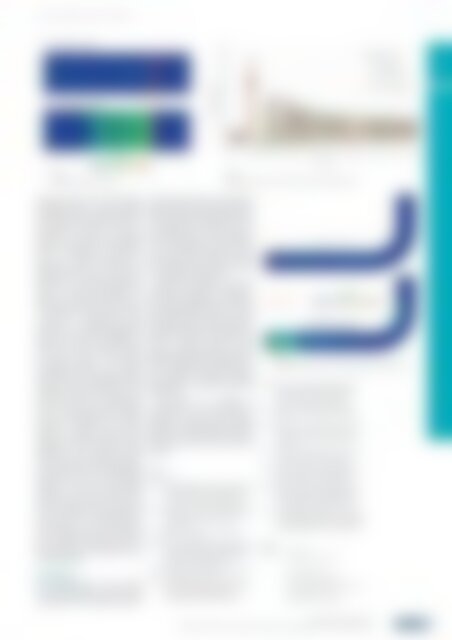atw - International Journal for Nuclear Power | 10.2020
Description Ever since its first issue in 1956, the atw – International Journal for Nuclear Power has been a publisher of specialist articles, background reports, interviews and news about developments and trends from all important sectors of nuclear energy, nuclear technology and the energy industry. Internationally current and competent, the professional journal atw is a valuable source of information. www.nucmag.com
Description
Ever since its first issue in 1956, the atw – International Journal for Nuclear Power has been a publisher of specialist articles, background reports, interviews and news about developments and trends from all important sectors of nuclear energy, nuclear technology and the energy industry. Internationally current and competent, the professional journal atw is a valuable source of information.
www.nucmag.com
Create successful ePaper yourself
Turn your PDF publications into a flip-book with our unique Google optimized e-Paper software.
<strong>atw</strong> Vol. 65 (2020) | Issue 10 ı October<br />
| Fig. 5.<br />
Cavitation effects at the check valve.<br />
without (green) and with cavitation<br />
modelling (red) at around 320 bar<br />
compared to 250 bar measured during<br />
the experiment (black). This overestimation<br />
is caused by deviation<br />
between real density and computed<br />
density according to the perfectFluid<br />
EOS. It is there<strong>for</strong>e necessary to<br />
implement either a better EOS <strong>for</strong><br />
high pressure ranges at high temperatures<br />
or use a fitting polynomial<br />
based on material properties to<br />
improve the peak quantity. After the<br />
initial pressure peak vapor pressure<br />
is reached at measurement point<br />
resulting in evaporation between<br />
check valve and RPV (Figure 7)<br />
leading to a delayed second pressure<br />
peak at 0.2 s. If no cavitation model<br />
is used the delay is not captured<br />
accordingly leading to an earlier<br />
second peak at 0.15 s while pressure<br />
drops near 0 bar. Applying the Kunz<br />
cavitation model the timing of the<br />
second peak fits the experimental<br />
data very well while the peak amplitude<br />
is underestimated at 160 bar<br />
compared to 190 bar. This further<br />
leads to a different frequency and<br />
amplitude of the following cavitation<br />
influenced three pressure peaks<br />
(0.25 to 0.4 s). A scaling of the empirical<br />
condensation and vaporization<br />
constants (eq. 10, 11) will probably<br />
improve the results in this regard.<br />
Looking at the well captured fifth<br />
pressure increase (0.45 s, red) as well<br />
as the upcoming reflection behavior<br />
(0.45 to 0.9 s) an overestimation of<br />
the frequency occurs. This deviation<br />
can be explained with either missing<br />
fluid structure interaction effects or<br />
from inaccuracies resulting from the<br />
perfectFluid EOS.<br />
Conclusion<br />
The implementation of the Kunz<br />
cavitation model <strong>for</strong> a multi fluid, fully<br />
compressible VOF approach improves<br />
the simulation results of the HDR test<br />
facility showing that cavi tation effects<br />
influence the water hammer phenomena<br />
significantly. Especially <strong>for</strong> the<br />
non-damped check valve implementation<br />
the dynamic pressure changes<br />
are in much better agreement to the<br />
experimental data as macro cavitation<br />
in the pipe section between check<br />
valve and RPV is considered.<br />
However, deviations of pressure<br />
amplitude still persist <strong>for</strong> high pressure<br />
peaks suggesting an improvement<br />
of the density calculation. As the<br />
perfectFluid EOS assumes a constant<br />
sonic speed pressure dependent compressibility<br />
changes are neglected. In<br />
order to capture effects of fluid<br />
structure interaction during the water<br />
hammer phenomena further development<br />
concerning the coupling interface<br />
preCICE [BUN16] between<br />
OpenFOAM-v7 and CalculiX [DHO18]<br />
will be done.<br />
The goal is to develop an<br />
OpenFOAM-v7 solver specialized to<br />
accurately model water hammer<br />
phenomena regarding high pressure<br />
changes, cavitation effects as well as<br />
fluid structure interaction <strong>for</strong> different<br />
systems.<br />
References<br />
[BRA19] Bratfisch, C.; Stahlberg, G.; Koch, M.K.: Simulation von<br />
Druckstoßphänomenen in kerntechnischen Anlagen<br />
mit ATHLET, Technical report regarding BMWi<br />
research project 1501522, January 2019, PSS-TR-6.<br />
[BUN16] Bungartz, H.J. et Al.: preCICE – A fully parallel library<br />
<strong>for</strong> multiphysics surface coupling, Research article,<br />
Computer & Fluids Volume 141 p. 250-258,<br />
December 2016.<br />
[DHO18] Dhondt, G.: CalculiX CrunchiX USER’S MANUAL<br />
version 2.14, April 2018.<br />
[GIO04] Giot, M. et al.: TWO-PHASE FLOW WATER HAMMER<br />
TRANSIENTS AND INDUCED LOADS ON MATERIALS<br />
AND STRUCTURES OF NUCLEAR POWER PLANTS<br />
(WAHALoads). Technical report, 2004.<br />
[GRE19] Greenshields, C. J.: OpenFOAM User Guide version 7.<br />
The OpenFOAM Foundation, 2019.<br />
[HDR81] KIT: HDR Sicherheitsprogramm – Untersuchungen<br />
an einem Speisewasserrückschlagventil NW 350<br />
bei Bruch einer Reaktorkühlmittelleitung.<br />
Kern<strong>for</strong>schungszentrum Karlsruhe (KIT), 1981.<br />
| Fig. 6.<br />
Simulation results <strong>for</strong> the non-damped check valve implementation.<br />
[KUN99] Kunz, R.F. et. Al.: A Preconditioned Navier-Stokes<br />
Method <strong>for</strong> Two-Phase Flows with Application to<br />
Cavitation Prediction, American Institute of<br />
Aeronautics and Astronautics (AIAA), 1999.<br />
[LUE13] Lüdecke, H. J. et al.: KSB Know-how, Band 1 Der<br />
Druckstoß. KSB Aktiengesellschaft, Halle (Saale),<br />
2013.<br />
[SAN13] Santiago, M.D.: An Extended Mixture Model <strong>for</strong> the<br />
Simultaneous Treatment of Short and Long Scale<br />
Interfaces, PhD thesis, Universidad Nacional del<br />
Litoral, 2013.<br />
[SIR17]<br />
Sirignano, W.A.: Compressible flow at high pressure<br />
with linear equation of state, research article,<br />
Cambridge University Press, December 2017.<br />
[VAL99] Valencia, L.; Bacher, H. P.: Rückbau des Heißdampfreaktors<br />
in Kahl am Main bei Aschaffenburg,<br />
Kern<strong>for</strong>schungszentrum Karlsruhe (KIT), 1999.<br />
[WAR13] Wardle, K.E.; Weller, H.G.: Hybrid Multiphase CFD<br />
Solver <strong>for</strong> Coupled Dispersed/Segregated Flows in<br />
Liquid-Liquid Extraction, <strong>International</strong> <strong>Journal</strong> of<br />
Chemical Engineering, Research Article, 2013.<br />
[YU17]<br />
| Fig. 7.<br />
Cavitation effects at the pipe section between check valve and RPV.<br />
Authors<br />
Yu, H.; Goldsworthy, L.; Brandner, P. A.; Garaniya, V.:<br />
Applied Mathematical Modelling 45 – Development<br />
of a compressible multiphase cavitation approach <strong>for</strong><br />
diesel spray modelling p. 705-727. ELSEVIER, 2017.<br />
Paul Fuchs<br />
paul.fuchs@pss.rub.de<br />
Prof. Marco K. Koch<br />
Ruhr-Universität Bochum<br />
Plant Simulation and Safety Group<br />
Universitätsstraße 150<br />
44801 Bochum, Germany<br />
RESEARCH AND INNOVATION 517<br />
Research and Innovation<br />
Water Hammer Simulation in Pipe Systems with Open Source Code OpenFOAM ı Paul Fuchs and Marco K. Koch

















